Tetanus is a highly fatal, toxemic disease of all domestic animals and humans, caused by the toxin of Clostridium tetani. Tetanus in cattle is characterized clinically by hyperesthesia, tetany, and convulsions. The causal agent of the disease is widely present in soil and animal feces. The spores of the organism are capable of persisting in the soil for many years. The disease is associated with disbudding, shearing, calving, naval infection, ear tagging, etc.
Important Information on Tetanus in Cattle
Tetanus is a less common disease in cattle, but it causes substantial economic loss in a cattle farm if outbreaks occur. The disease is caused by the neurotoxin produced by bacteria Clostridium tetani and causes stiffness of muscles, especially in mastication muscle. The name of the disease also “Lockjaw.” All age groups of cattle are vulnerable to this disease but stressed animals are more vulnerable.
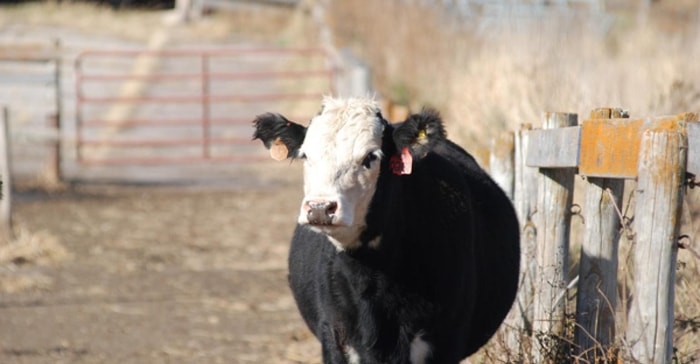
Causes of Tetanus in Cattle
The disease is caused by the potent neurotoxin (Tetanospasmin, Tetanolysin) produced by Clostridium tetani. The organism is a gram-positive, spore-forming, and anaerobic bacteria. The organism presents typically in the soil and animal feces. The organism is opportunistic and affects the host during their weak moments, especially after any stress.
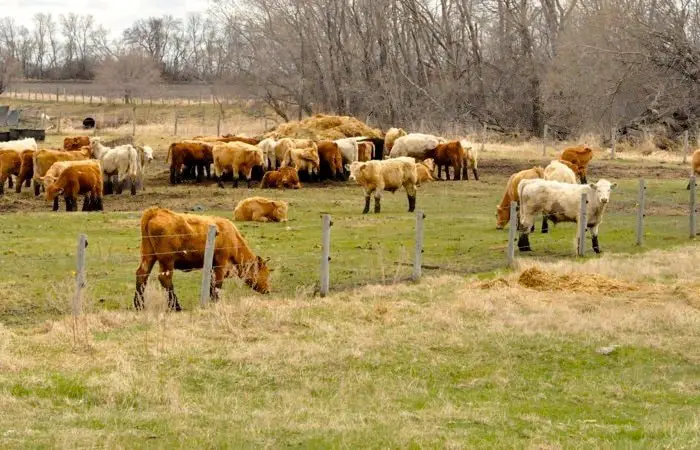
Pathogenesis of Tetanus in Cattle
Pathogenesis is very important to know the development of any disease. The pathogenesis of tetanus are as follows:
- Clostridium spores enter into body from the soil through any wound.
- The spore grows only in the anaerobic condition that is in tissues without any process of oxidation-reduction.
- The deep cuts and contamination usually make the condition of the cuts by deposition of the small amount of soil and foreign bodies or by punctured wound caused by rusted nils leading to necrosis of the tissues.
- The organism multiply, undergo autolysis and releasing the potent neurotoxin.
- The motor nerve absorbs the toxin and passes it up the nerve tract to the spinal cord causing ascending tetanus.
- The excess toxins are carried by the lymph to the bloodstream and then to the central nervous system, causing descending tetanus resulting in clinical signs and death.
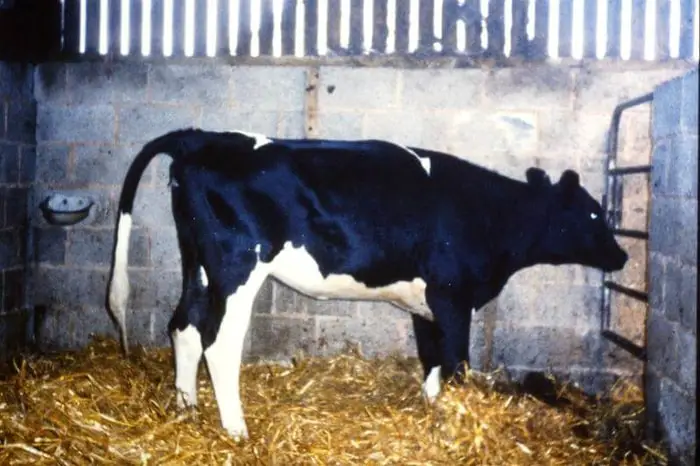
Clinical Signs of Tetanus
The disease is highly fatal, and many animals died before showing any clinical signs.
- The incubation period of the disease usually 10-14 days.
- Initially, the animal shows muscle stiffness accomplished by muscle tremors.
- Lockjaw and unable to masticate by mouth.
- Unable to walk or move due to stiffness of joints.
- Reluctant to eat or drink, progressive emaciation, and dehydration.
- Bloats may be developed due to the stoppage of work by the rumen.
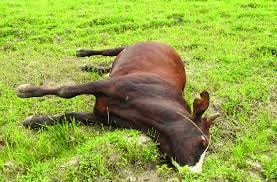
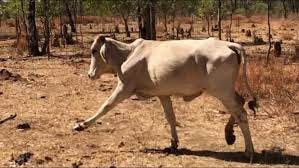
- Other signs are erect carriage of the ears, retraction of the eyelids and dilatation of the nostrils, and exaggerated responses to normal stimuli.
- Later there is the regurgitation of food and drooling of saliva.
- There are tetanic convulsions in the terminal stage of the disease, opisthotonos, and the animal adopts a “sawhorse” posture.
- The animal sweats profusely, and there is a rise in temperature (108- 110 F) before death.
Pathological Lesions of Tetanus
There are no specific gross or histopathological signs for the diagnosis of the disease.
Diagnosis of Tetanus in Cattle
The presumptive diagnosis of the disease is made mainly by:
- History, clinical signs, and symptoms.
- Isolation and identification of the organism from the infected wound.
- There is no specific test available to confirmatory diagnose the disease.
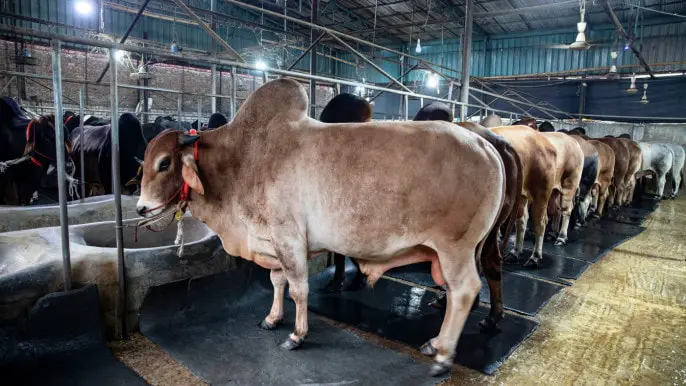
Differential Diagnosis of Lockjaw in Cattle
The initial stage of the disease may be confused with the following diseases:
- Strychnin poisoning ( may affect several animals at a time).
- Hypocalcemic tetani ( confined to lactating animals only).
- Acute laminitis ( no tetany and prolapse of the third eyelids).
- Cerebrospinal meningitis (rigidity of the neck, hyperaesthesia, and hypersensitivity to sound and movement).
- Lactation tetany (tetany and convulsion are more severe).
- Ketosis.
- Enterotoxemia in sheep and goats.
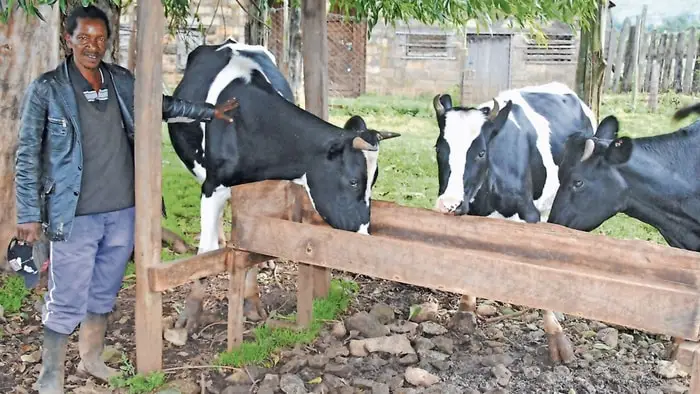
Treatment Procedures of Tetanus in Cattle
The treatment and management procedures of tetanus in farm animals are as follows:
- Cleaning of the wound, exposure to air, flashing with Hydrogen peroxide and applying penicillin locally and by injection.
- Anti-tetanus serum (ATS) may be given and which will effective up to 8 hours after injection.
- Suladiminin injection can be given and continued till 27 days.
- The supportive therapy includes intravenous electrolytes, nutrients, and Vitamin B complex injections.
- The use of tranquilizers is also effective.
- The dose of ATS varies from 10,000 to 1,00,000 Units per animal. Usually, the initial dose is 15,000 units under the skin to reduce the effect of the Tetanus Neurotoxin (TeNT).
- The mortality (death) rate may reach up to 50%, and other animals recovered after proper treatment.
- Mild cases recovered within one week after necessary treatment.
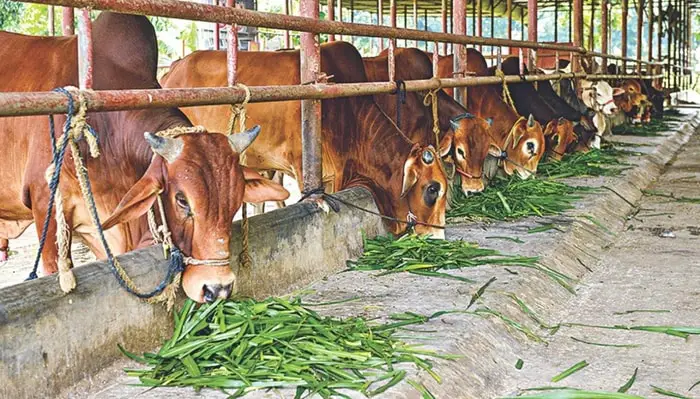
Prevention and Control of Lockjaw in Cattle
Preventive measures should be taken at every operation and wound management.
- The sterilized instrument should be used during any operation.
- The surgical operation should be done in clean surroundings with proper postoperative treatments.
- Tetanus toxoid (TT) should be given to animals before shearing, docking, deliveries, and any injuries and after parturition to calves.
- TT takes 14 days to produce protective antibodies, and if protection is needed earlier, it is better to give ATS.
Tetanus Vaccines for Cattle
Vaccines against tetanus are available and will boost immunity after 14 days of the second dose in cattle. Vaccination is done by Tetanus Toxoid (TT) that is inexpensive. In an immediate case, ATS is given to treat the animal. In the case of castration, you can give both TT and ATS to the calf to treat and prevent further development of antibodies.
Final Advice on Tetanus in Cattle
Though tetanus is a sporadic disease in cattle, there is a considerable risk of disease in your herd. The risk factors should be managed well. It would be best if you gave TT before any operation, castration, docking, dehorning, disbudding, shearing, and management of any wound. The deep wound should be opened and cleaned with potential antiseptics.